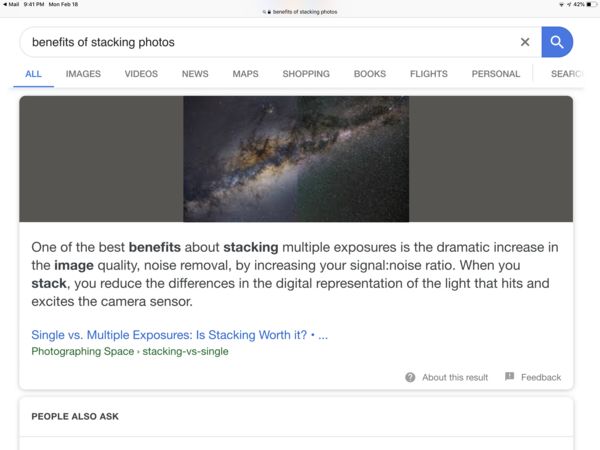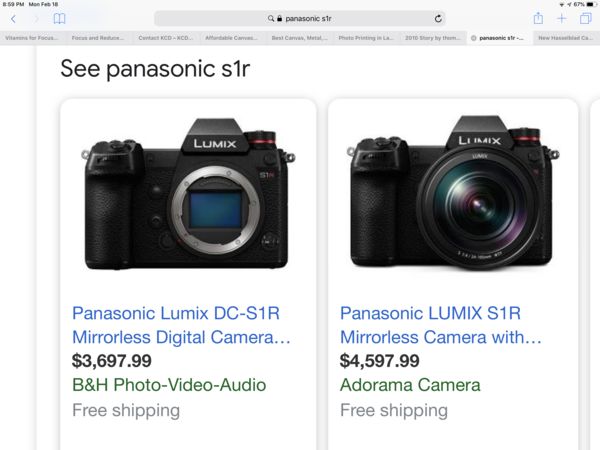Posts for: tdekany
Feb 19, 2019 05:39:21 #
Cdouthitt wrote:
Sony went from 5% to 15% in Olympus
Feb 19, 2019 00:42:14 #
speters wrote:
It solely depends on ones intend, it does has noth... (show quote)
Feb 19, 2019 00:08:17 #
Bipod wrote:
It would be nice if mirrorless makers would pass the savings along. So far, that seems to be
happening only with Panasonic.
happening only with Panasonic.
Why not dslrs?
And where did you get the idea that Panasonic passes on the savings? Are you smoking funny cigarettes? Businesses are into making profits. Do you think Panasonic became a multi billion dollar corporation by passing on the savings? 😂
Thanks for the laugh though!!!
In reality, Panasonic priced both of their new FF mirrorless cameras higher than Sony/canikon
Did you know that you can google? It is free on your computer. 2 for 2 tonight. You should change your user name to FAKE NEWS
Feb 18, 2019 23:45:15 #
gessman wrote:
This article should explain it to your satisfaction if you read the entire thing: https://www.cambridgeincolour.com/tutorials/focus-stacking.htm
Here's another url leading to another part of the explanation:
https://digital-photography-school.com/automatic-exposure-bracketing-aeb/
You can also get some answers to other questions from the two urls above as well as from Wikipedia: https://www.wikipedia.org/
Here's another url leading to another part of the explanation:
https://digital-photography-school.com/automatic-exposure-bracketing-aeb/
You can also get some answers to other questions from the two urls above as well as from Wikipedia: https://www.wikipedia.org/
I don’t think that op means focus stacking.
To answer the op, you take the shots at the same time. I’m not aware of doing it at different times. In any case, colors will improve and you reduce noise at least. Basically, you improve IMAGE QUALITY.
Feb 18, 2019 23:38:47 #
MrBob wrote:
I would buy one in a heartbeat if I had the bucks; don't really care if I need it or not ! I think Olympus technology is great... they are always on the edge. Of course that is just the collector part of me. Contrary to popular belief it is not their Flagship model or the next iteration of the M1.
It is a flagship model. Just like the 1dx and D5
Feb 18, 2019 23:37:44 #
BebuLamar wrote:
And so far I haven't heard anyone who would want to buy one yet. So I don't think it would sell well.
I seriously doubt that you frequent m4/3 forums. If you did, you would know that there are many who have preordered it. Some ordered 2. But it isn’t available until the 25th.
Feb 18, 2019 21:10:06 #
Bipod wrote:
No creative art can thrive in a vacuum. There has... (show quote)
You should try to get your facts straight.
The most expensive photograph is made by Peter Lik "Phantom" (2014) - $6,5 million
Feb 16, 2019 16:10:15 #
How about a gift certificate at one of the large retailers or Amazon?
Feb 16, 2019 15:59:27 #
Feb 15, 2019 23:34:17 #
Bipod wrote:
So how would you explain the more than 70% declin... (show quote)
Quote:
In 2014, according to Mary Meeker's annual Internet Trends report, people uploaded an average of 1.8 billion digital images every single day. That's 657 billion photos per year. Another way to think about it: Every two minutes, humans take more photos than ever existed in total 150 years ago.Nov 2, 2015
As usual, you are extremely negative. I guess that is just your nature.
The way I look at it is different. Having a cell phone camera in most people’s hands provides opportunities to record moments that otherwise wouldn’t happen. So it is a very good thing that most of us have smart phones. Many of those photos will be unique and one of a kind. That can not be a bad thing.
As far as musicians being compared to photographers? It is illogical.
A musician is a person who can play an instrument and/or a pro. A person pressing the shutter on a cellphone or on a camera is not a pro or a great photographer necessarily just because they own a camera device.
On top of that, having a large format camera didn’t guarantee work of art. Just like today. Owning expensive gear produces way more snapshots than quality photographs.
Lastly, lots of people prefer to eat in fast food joints, instead of trying to learn to cook with organic ingredients to prepare quality meals. I’m going to guess that you are one of those guys.
So next time you decide to judge people for how they spend their money, what devices they use to record a moment in time, do look in the mirror first. There are plenty of things wrong with you.
And lastly, please stop being a hypocrite. Be the change you want to see in the world. Meaning, don’t judge us for using “””miniature “”” format cameras (FF, APSC, M4/3) when we are out and about taking photos with gear that we like to use and are happy with, WHILE you go out on your hikes with a 15 year old 4mp P&S camera. Go and carry your LF camera system everywhere. Don’t expect us to do it, if you are not willing to do the same.
Feb 15, 2019 23:01:49 #
Chris T wrote:
The GFX 50R is four grand. The GFX 50S is $6500. The GFX 100 is ten grand.
Why, Tom? … interested?
Why, Tom? … interested?
You called a $3000 camera $5000 because you need lenses. So that $4000 Fuji is more like $8000
Feb 15, 2019 21:43:21 #
Chris T wrote:
The 33-64 is just $2300, the 23 UWA is just $2600, and the 120 Macro is $2700 … that's all I'd need!
What about the camera?
Feb 15, 2019 19:01:06 #
Chris T wrote:
Just as with most things - you have NOT read the entire thread - or you'd have seen the corrections.
USER - don't worry about my digestion. Four grand (with lens) I don't have, anyway …
But if I did, and it was spare, I'd sooner get the Fuji GFX 50R - a MF MILC - for that same four grand!
USER - don't worry about my digestion. Four grand (with lens) I don't have, anyway …
But if I did, and it was spare, I'd sooner get the Fuji GFX 50R - a MF MILC - for that same four grand!
You can get it for $4000 with lens?
Feb 15, 2019 17:21:01 #
le boecere wrote:
So, am I to read in what you and the M4/3rds community are saying, here, that; there's no real need for any sensor other than the M4/3, as it is superior to all other sensor sizes? (Yes, of course the phone-cameras still need a tiny sensor, but in "real cameras"?)
Would you in your wildest dream think that someone would say yes to that question? Come on now.
Instead go out there and produce award winners with your FF gear. Use what you need.
Feb 15, 2019 17:16:20 #
Chris T wrote:
Yes, I made a mistake … so sue me!!!!
The 1" sensor is 8x smaller than FF - approximately …
Check the chart I just sent you, Tom - pretty much ALL formats are listed.
It gives you the width and length. Multiply those and you have the area …
Then - you can much more easily compute the difference. FF is 864 sq. mm.
The 1" sensor is 8x smaller than FF - approximately …
Check the chart I just sent you, Tom - pretty much ALL formats are listed.
It gives you the width and length. Multiply those and you have the area …
Then - you can much more easily compute the difference. FF is 864 sq. mm.
Chris, you thought 1” was larger than m4/3 earlier.
I also sent you 2 articles from people who have tested and use m4/3. Not opinions.
However, I personally don’t care what camera was used, I am more interested in the end result.

